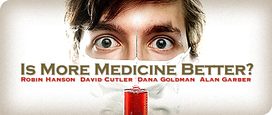What is the effect of a price increase? The conventional answer that quantities consumed will decrease along a demand curve doesn’t always apply in health care. The question isn’t even answerable without describing which price is being increased and specifying the mechanism for the price increase. The price of a medical product or service usually means the price paid by insurers, along with the copayment and other out-of-pocket payments by the consumer. But the copayment may be a small part of the total, and the copayment may not rise at all with a price increase. An increase in the price the manufacturer charges for a drug, whether it’s branded or generic, typically will not result in an increase in the out-of-pocket cost to the consumer if the drug remains in the same tier of a tiered formulary. It is the very lack of price sensitivity that is able to support such high prices for biological products used to treat cancer.
The price that matters for consumption, of course, is the price faced by consumers. High-deductible health plans are designed to increase the price directly paid by individuals for the care they consume. It is still too early to know whether high-deductible plans drive consumers to make better health care choices. But price increases of this kind are generally unachievable in traditional Medicare. If Medicare copayments are increased in an effort to increase the price faced by the consumer, much of the time there will be no effect on consumption, because most Medicare beneficiaries have supplemental insurance that pays for a large share of Medicare copayments and deductibles. It’s not clear how the Centers for Medicare and Medicaid Services could raise the prices faced by beneficiaries who have a second layer of insurance coverage.
Capping or eliminating the tax exclusion for health insurance would be one way to increase the effective price of insurance, and it would undoubtedly diminish the incentives to consume too much care. But considering the uproar over any attempt to limit the tax exclusion for health insurance — think of President Bush’s proposal to cap the exclusion at $15,000 for families and $7,500 for individuals — this does not seem to be a policy that will go anywhere. It would have better chances if it were linked to features that ensured that patients who could derive a great deal of benefit from high-value treatments would continue to get them. And that requires changes in benefit design, not changes in the tax treatment of health insurance.
So developing a policy to raise prices faced by consumers, and to ensure that it has the desired incentive effects, is a tall order. It’s better to do it the right way — selectively — than crudely. I don’t think that changes in reimbursement that would lead to selective reduction in low-value services are beyond our reach, even though we are still learning about the best approaches. I’m not sure what “simple crude cuts” mean, but if they’re not well placed, adverse health effects are inevitable and could be large, and are likely to be experienced first by the most vulnerable populations. The complexity of redesigning insurance is a small problem compared to the consequences of ill-directed spending cuts.

